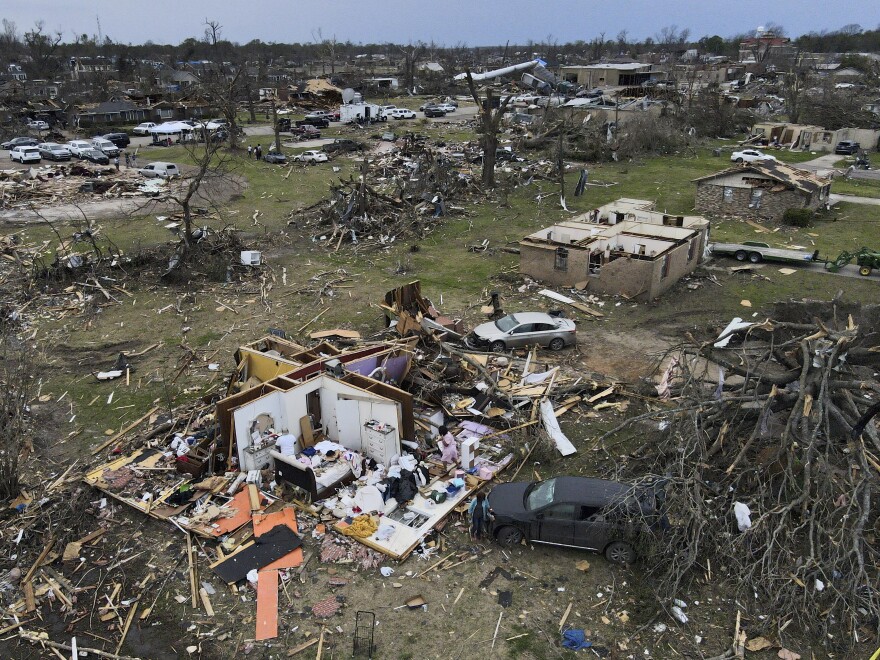America's tornado warning system is a patchwork of municipal sirens, cell phone alerts, and radio and TV messages. But even as forecasting for dangerous storms improves, people who live in rural areas too often miss the life-saving warnings.
Last month, a catastrophic tornado outbreak in Mississippi killed at least 26 people. A tornado rated 4 out of 5 on the Enhanced Fujita Scale landed in Rolling Fork around 8 p.m. and was on the ground for an hour and 10 minutes, raging through the communities of Winona, Black Hawk and Silver City.
Victor Gensini, an associate professor of meteorology at Northern Illinois University, pins the rising probability of tragedies like Rolling Fork on multiple factors, including climate change, population growth, poverty, urban sprawl, and weak construction.
"A disaster itself is really a function of two things," Gensini tells NPR. "Number one is the physical risk of the hazard in this case, a particular tornado, and also the human vulnerability component ... how humans build along the landscape, how we cluster, how strong our structures are."
In Rolling Fork, as in many parts of the U.S., people who live in mobile homes often have no basement for sheltering from a storm. And Gensini says more than half of all tornado fatalities occur in weak-frame housing, "basically, like mobile home structures."
Climate change may exacerbate that risk. As global temperatures rise, some climate models suggest that the weather patterns that fuel tornadoes could become more common. A study co-authored by Gensini and published this year by the American Meteorological Society (AMS) predicted that by the end of the century, the average annual number of supercells — rotating storms known for producing monster tornadoes — could increase by 6.6% in the eastern U.S.
It remains unclear whether climate change or advances in the ability to monitor and study storms like tornadoes is driving that expansion. But Gensini says concepts like tornado "alley" and tornado "season" are outdated because they no longer capture how these storms behave.
"In reality, tornadoes don't really care what state it is, so to speak, and they certainly don't care what time of year it is," Gensini says. "There is a substantial climatological risk of tornadoes in most places east of the Rockies in the United States."
Luckily, Gensini says, improved forecasts for severe weather keep getting better. "Twenty years ago, we wouldn't even dream about trying to make a next day tornado forecast."

Why don't advanced tornado forecasts reach everyone?
"The science is there, the technology is there, the modeling is there, the forecasts are there. But we continue to see fatalities and casualties from these events because we're not getting across the finish line," Gensini says.
Experts say gaps in cell phone coverage and proximity to warning sirens and TV and radio play a part.
The National Weather Service (NWS) partners with the Federal Emergency Management Agency (FEMA) to send push alerts to smartphones when there is severe weather. But that only works with reliable cell service.
Kim Klockow-McClain, a senior scientist at The National Oceanic and Atmospheric Administration (NOAA) Centers for Environmental Prediction, says weather messaging is delivered and people are then left to make decisions about how they want to be warned - by a favorite weather forecaster, a phone vibration, or a county siren. Klockow-McClain says warnings become a "social process."
"What we see is a lot of rural places receiving the poorest overall service, mainly in places that intersect with other social vulnerability factors like income and race," Klockow-McClain tells NPR.
Eleven minutes before last month's disaster in Mississippi, the NWS warned that a storm capable of producing tornadoes was headed for Rolling Fork. That warning triggered TV, radio and cell phone alerts, but residents of the small, predominantly Black city told The Washington Post they heard no warning sirens.
Even so, TV meteorologists interrupted March Madness to get the word out.
But Klockow-McClain, who used to work at the Severe Storms Laboratory in Norman, Okla., tells NPR communities can't always count on TV, because meteorologists may be under pressure to avoid breaking into primetime programming.
"Some station management has given meteorologists feedback in the past that they really want you to think about that," she says.
What about radio?
Sirens, Klockow-McClain says, are vital in rural, low-income communities. "Sirens can be a gap filler when nothing else is especially accessible or works well."
The AMS traces the history of the siren system to the Cold War when they were installed, not to warn about tornadoes, but to sound the alarm of an imminent attack. But the sirens are expensive to maintain and can't be heard everywhere.
For people out of siren or cell range, Klockow-McClain recommends a NOAA weather radio to sound an alarm. They're battery operated and come in a range of prices, starting at about the cost of a smoke and carbon monoxide detector for the home. But even though the weather service says it wants the radios to be as common as smoke detectors, only about 3-4% of the population has one.
"NOAA weather radio ... transmits warnings automatically. You can select different hazard types that you're interested in. If you're just interested in tornadoes, you can set it to that," Klockow-McClain says. "It's been something the weather service has been trying to get disseminated throughout the country for decades."
In Indiana, all new mobile homes are required by law to be equipped with a weather radio. The law honors 2-year-old C.J. Martin, who was killed in 2005 after a tornado tore through his mobile home community in the middle of the night. That storm killed 25 people.
Klockow-McClain says more people need to have a reliable warning system in their homes. "Especially at night when you really need something to reach out to you, NOAA weather radio is an amazing technology."
Jan Johnson, Simone Popperl and Rebecca Hersher contributed editing. contributed to this story
Copyright 2023 NPR. To see more, visit https://www.npr.org.



